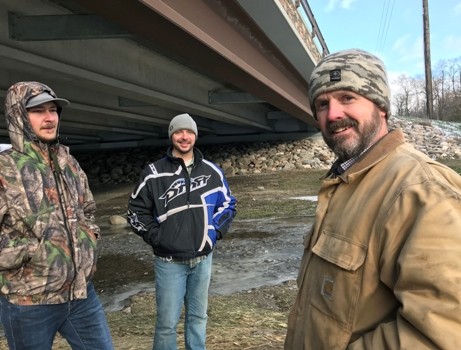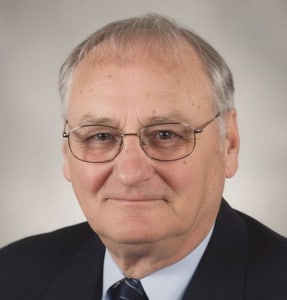Pennington Soil & Water Conservation District’s planned streambank stabilizations in Thief River Falls would prevent a sewer line from unleashing pollutants directly into the Red Lake River, protect personal property on the brink of an undercut bluff, and reduce erosion across from Oakland Park.
A $542,640 Clean Water Fund grant from the Minnesota Board of Water and Soil Resources will cover 75% of the cost. Thief River Falls will cover the rest, drawing from its stormwater enterprise fund and potentially pursing other grants.
Construction could begin this year. Work is in the planning and permitting stages.
“The goal is to reduce sediment entering the Red Lake River, which is contributing to an impairment,” Peter Nelson said during a November 2019 stop at the Greenwood Street bridge, near the site of the sewer line and the city’s second-highest-volume lift station. Pennington SWCD’s water plan coordinator at the time, Nelson is now the district manager.
Downstream, the Red Lake River is impaired for sediment. It enters the Red River, which flows to Lake Winnipeg. Excessive phosphorus fuels Lake Winnipeg’s blue-green algae blooms. Increasingly frequent over the past 30 years, the blooms have at times covered more than 50% of the lake’s surface.
Initial estimates show the three stabilizations would keep 385 tons of sediment — nearly 29 dump truck loads — out of the Red Lake River annually.
The sites are among 10 priorities for reducing sediment and phosphorus that Houston Engineering identified in a water-quality study funded by a previous $60,560 Clean Water Fund grant. State highway projects will address six of those.
The seventh, a $500,000 oxbow restoration and stormwater treatment project, received funding in December 2020 when the Red Lake Watershed District was awarded a $250,000 Clean Water Fund grant.
“They’re very expensive projects. Without the Clean Water Funds, we wouldn’t be able to implement these projects,” Nelson said.
The Pennington SWCD streambank stabilizations likely will start with the site that’s part of the city’s wastewater treatment infrastructure. Here, erosion sped up after the new Greenwood Street bridge, built about 10 years ago, altered the course of the river. The lift station treats 750,000 gallons a day — including wastewater from a poultry processing plant, a long-term care facility and residential neighborhoods.
Thief River Falls Water Systems Superintendent Wayne Johnson described the system:
Gravity moves the wastewater through a 20-inch line to a lift station situated at a lower elevation along the river. When wastewater in that lift station’s well reaches a certain depth, a pump pushes it uphill to the next lift station through a 16-inch line. That line, currently 50 feet from the riverbank, would breach if it were exposed.
“We’re not getting to the point where it’s going to be exposed next year. We’ve probably been losing 3 to 4 feet of riverbank a year for the last 10 years. It’s not impacting the bridge abutment. It’s not impacting the lift station itself. But eventually it would encroach on that force main, on that large pipe,” Johnson said.
Plans for the private property, visible from the LB Hartz Park walking bridge, were under review this winter by Minnesota Department of Natural Resources staff. Plans for the downstream residential site across from Oakland Park were being engineered.
All three sites lie within three-quarter-mile-long stretch of the Red Lake River in downtown Thief River Falls.




